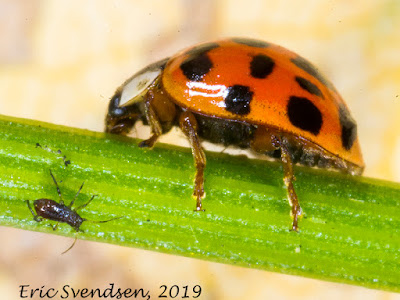The katydid
 |
| Adult katydid |
It is easy to tell a katydid from a grasshopper; katydids are completely green. While grasshoppers may have green on them, they frequently are brown and have mottled wings and thorax. Katydids also have ridiculously long antennae. A grasshopper's antennae are very short, maybe the length of their head. A katydid's antennae are two to three times as long as their bodies though. Katydids are sometimes called long-horned grasshoppers.
Katydids can be garden pests, but usually not serious ones. I found one yesterday morning as I was painting the fence which borders the back of my property. A juvenile katydid, less than a centimeter long, was stuck. It had just shed its skin (called an ecdysis) and was still partly attached to it. It is not my habit to take the life of an innocent creature, although admittedly I am responsible for the death of several thousand mosquitos over the course of my lifetime. I tried to pick it off the fence with my hands, but was certain its diminutive size would have succumb to my grip, no matter how gentle I was. So, I found a small stick and managed to free it from its most recent molt.
What I really liked about this tiny insect was its incredibly long antennae. I could have measured it in inches. It was amazing to see this delicate organism with these long projections from its forehead. I released it in my garden. The slugs and snails were going to do 100x more damage to my plants than this would. Besides, katydids make wonderful songs at night. You would never hear something like that from a slug!



Comments
Post a Comment